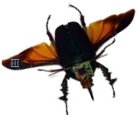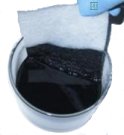Flying Yacht: Innovative Future
The brainchild of French designer Yelken Octuri who also designs cabins for Airbus, this ‘Flying Yacht’ concept combines his knowledge of aircraft design with love for seas to create this outlandish concept yacht. We have seen many seaplane concepts so far, but this one surpasses them all as greatest does the least. Flying Yacht idea doesn’t seem as weird or far-fetched, as many engineers and designers have already approached him to turn it into reality.When on the water, each of the four mobile masts reaches a height of 40-meters and can be individually oriented through a double-jack system, which ensure optimal positioning regardless of wind direction. Sails are stored in compartments located inside the each mast that are further lowered down to work as horizontal wings. This amazing 46-feet long trimaran sailing yacht converts from super yacht to glamorous jet plane with the help of four mobile masts.
Insect Robots

Advances in microelectronics is making yesterday's science fiction into tomorrow's future inventions.
Scientists at the University of California have implanted beetles with miniaturized electronics that allows the insects to be controlled.
Research presented at a conference in Italy demonstrated a new technology for creating "cyborg insects".
The flying beetles receive wireless signals from a mobile transmitter that controls the insect. Varying impulses trigger an appropriate response from the beetle so that it flys according to it's handler.
The insect can be made to take-off, land, hover, or follow a given flight path.
Previous research concentrated on moths but giant flower beetles were easier to operate and could carry larger payloads because of their size.
Further advances with nanobots and miniaturization will allow heat sensors and cameras to be embedded into the bugs. The insect could then be used for surveillance or search and rescue missions.
Source: eecs.berkeley.edu/Faculty/Homepages/maharbiz.html
Electrical Clothing
 One of the future inventions that could greatly impact our lives are nanoribbons.
One of the future inventions that could greatly impact our lives are nanoribbons. Rubber films developed by engineers at Princeton University could power mobile devices and other electronic devices.
The silicone sheets are embedded with ceramic nanoribbons (piezoelectric ribbons) that generate electricity when flexed, converting mechanical energy to electrical energy.
Materials made of this material, such as shoes, would harvest electrical energy created from walking and power everything from an ipod to a pacemaker.
The nanoribbon strips are so narrow that 100 fit side-by-side in a space of a millimeter. The strips are then embedded into clear sheets of silicone rubber to create a chip.
These sheets could be woven into fabric and placed against any moving area on the body to create electricity.
For example, a vest made from this material could take advantage of breathing motions to generate energy.
Nanoribbons are highly efficient in converting about 80% of mechanical power into electricity.
Source: princeton.edu/main/news/research












 Scientists at Standford University are developing future inventions using e-Texiles.
Scientists at Standford University are developing future inventions using e-Texiles.  One of the future inventions in health care may be the development of a spray gun for regenerating skin tissue.
One of the future inventions in health care may be the development of a spray gun for regenerating skin tissue.  Among the future inventions in e-readers is this paper thin, flexible film that reads like a magazine or newspaper.
Among the future inventions in e-readers is this paper thin, flexible film that reads like a magazine or newspaper.